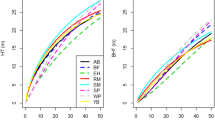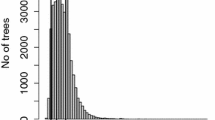Abstract
Air pollution, harvesting practices, and natural disturbances can affect the growth of trees and forest development. To make predictions about anthropogenic impacts on forests, we need to understand how these factors affect tree growth. In this study the effect of disturbance history on tree growth and stand structure was examined by using a computer model of forest development. The model was run under the climatic conditions of east Tennessee, USA, and the results compared to stand structure and tree growth data from a yellow poplar-white oak forest. Basal area growth and forest biomass were more accurately projected when rough approximations of the thinning and fire history typical of the measured plots were included in the simulation model. Stand history can influence tree growth rates and forest structure and should be included in any attempt to assess forest impacts.
Similar content being viewed by others
Literature cited
Bormann, F. H. 1965. Changes in the growth pattern of white pine trees undergoing suppression.Ecology 46:269–277.
Botkin, D. B., J. F. Janak, and J. R. Wallis, 1972. Some ecological consequences of a computer model of forest growth.Journal of Ecology 60:849–872.
Dale, V. H., M. Hemstrom, and J. F. Franklin. 1986. Modeling the long-term effects of disturbances on forest succession, Olympic Peninsula, Washington.Canadian Journal of Forest Research 16:56–67.
Doyle, T. W. 1981. The role of disturbance in the gap dynamics of a montane rain forest: an application of a tropical forest succession model. Pages 56–73in D. C. West, H. H. Shugart, and D. B. Botkin (eds.), Forest succession concepts and application. Springer-Verlag, New York.
Doyle, T. W. 1983. Competition and growth relationships in a mixed-age, mixed-species forest community. Unpublished PhD dissertation, University of Tennessee, Knoxville, Tennessee.
Franklin, J. F., K. Cromack, Jr., W. Denison, A. McKee, C. Maser, J. Sedell, F. Swanson, and G. Juday. 1981. Ecological characteristics of old-growth douglas-fir forests. US Department of Agriculture Forest Service General Technical Report PNW-118.
Fritts, H. P. 1976. Tree rings and climate. Academic Press, London, 567 pp.
Harcombe, P. A. 1986. Stand development in a 130-year-old spruce-hemlock forest based on age structure and 50 years of mortality data.Forest Ecology and Management 14:41–58.
Hett, J. M. 1971. Land use changes in east Tennessee and a simulation model which describes these changes for three counties. ORNL IBP-71-8. Oak Ridge National Laboratory, Oak Ridge, Tennessee.
Hileman, B. 1984. Acid rain meeting in Ottawa.Environmental Science and Technology 18:157.
Johnson, D. W., R. I. van Hook, and A. L. Ragan. 1987. Biogeochemical cycling in Walker Branch watershed: a synthesis of research results. Springer-Verlag, New York.
Kitchings, J. T., and L. K. Mann. 1976. A description of the terrestrial ecology of the Oak Ridge Environmental Research Park. ORNL/TM-5073. Oak Ridge National Laboratory, Oak Ridge, Tennessee, 58 pp.
Likens, G. E. 1985. An experimental approach for the study of ecosystems.Journal of Ecology 73:381–396.
Long, J. N., and J. Turner. 1975. Aboveground biomass of understory and overstory in an age sequence of four Douglas-fir stands.Journal of Applied Ecology 12:179–188.
McLaughlin, S. B. 1985. Effects of air pollution on forests: A critical review.Journal of the Air Pollution Control Association 35(5):512–534.
Oliver, C. D. 1981. Forest development in North America following major disturbances.Forest Ecology and Management 3:153–168.
Oliver, C. D., and E. P. Stephens. 1977. Reconstruction of a mixed-species forest in central New England.Ecology 58:562–572.
Pastor, J., and W. M. Post. 1986. Influence of climate, soil moisture, and succession on forest carbon and nitrogen cycles.Biogeochemistry 2:3–17.
Plochmann, R. 1984. Air pollution and dying forests of Europe.American Forests 90:17.
Pyle, C. 1985. Vegetation disturbance history of Great Smoky Mountains National Park: an analysis of archival maps and records. National Park Service Research/Resources Management Report SER-77.
Runkle, J. R. 1982. Patterns of disturbance in some oldgrowth mesic forests of eastern North America.Ecology 63:1533–1546.
Siccama, T. G., M. Bliss, and H. W. Vogelmann. 1982. Decline of red spruce in the Green Mountains of Vermont.Bulletin of the Torrey Botanical Club 109:163.
Shugart, H. H. 1984. A theory of forest dynamics. Springer Verlag, New York, 278 pp.
Shugart, H. H. and D. C. West. 1977. Development of an Appalachian deciduous forest succession model and its application to assessment of the impact of the chestnut blight.Journal of Environmental Management 5:161–179.
Sollins, P., D. E. Reichle, and J. S. Olson. 1973. Organic matter budget and model for a southern Appalachian Liriodendron forest. EDFB/IBP-73/2. Oak Ridge National Laboratory, Oak Ridge, Tennessee.
Solomon, A. M., M. L. Tharp, D. C. West, G. E. Taylor, J. W. Webb, and J. L. Trimble. 1984. Response of unmanaged forests to CO2-induced climate change: available information, initial tests and data requirements. NBB-0053 Department of Energy, Washington, DC.
Thornthwaite, C. W., and J. R. Mather. 1957. Instructions and tables for computing potential evapotranspiration and water balance.Publications in Climatology 10:183–311.
Wierman, C. A., and C. D. Oliver. 1979. Crown stratification by species in even-aged Douglas-fir/western hemlock stands of coastal Washington.Canadian Journal of Forest Research 9:1–9.
Author information
Authors and Affiliations
Rights and permissions
About this article
Cite this article
Dale, V.H., Doyle, T.W. The role of stand history in assessing forest impacts. Environmental Management 11, 351–357 (1987). https://doi.org/10.1007/BF01867163
Issue Date:
DOI: https://doi.org/10.1007/BF01867163




